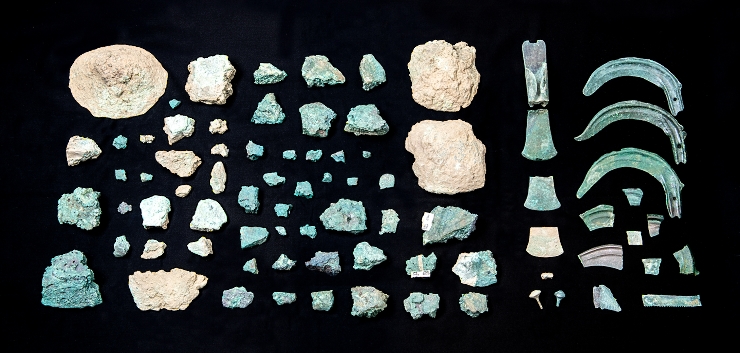Pěknej depůtek, dvacet kilo - to muselo být tehdy značné jmění.... Ekvivalent dvou koní, měchu medoviny a tří blonďatých zajatkyň 
Detectorist finds 3,000-year-old huge Bronze Age treasure in the Alps
Categories: Treasures , Nálezy nejenom s detektorem v západní Evropě
A treasure dating back to the 12th to 11th century BC was discovered at the site of a Roman battle in the Oberhalbstein Alps with the help of a metal detector. It contains over 80 bronze objects weighing a total of 20 kg. It is the largest and most important Bronze Age treasure ever found in the canton of Graubünden.
Hundreds of Roman artefacts, including sling shots, nails, pieces of military equipment and weapons, including, for example, a richly decorated dagger, have been found repeatedly near the present-day village of Surses since 2003. The huge number of artefacts from the Augustan era identifies the site of a large-scale military action between mySuanetes tribes and three Roman legions led by the future emperor Tiberius and his brother Drusus in 15 BC. AD. This is the only documented Roman battlefield in Switzerland. In 2008, the remains of a Roman military summer camp, established to control the strategically important Septimer Pass, were discovered here.
In 2021, a new research project was launched at the site to systematically survey the landscape to discover historical traces of the conflict. As part of this project, a Late Bronze Age treasure was discovered in a field south of a prehistoric settlement along a transalpine trade routewhen its first signals were detected last October by an amateur detectorist from the Archaeological Service of Graubünden (ADG).
Subsequent research revealed that the objects were densely and carefully packed in a small, clearly demarcated pit. Originally they were wrapped in leather, placed in a wooden box and buried as a whole in the ground. Most of the objects are raw copper pieces and ingots, which were used in the manufacture of metal objects throughout the Alpine region. Other artefacts include sickles, axes, saw fragments and pieces of jewellery. They were deliberately damaged, figuratively 'killed' so that they could not be reused before they were placed in the ground.
"The comprehensive scientific research that will now follow this find, which is unique in our areawill certainly provide far-reaching insights into the cultural, economic and landscape history of the Late Bronze Age," said Thomas Reitmaier, archaeologist for the canton of Graubünden. "It also underlines the potential for extensive archaeological research and cooperation with volunteer detectorists," he added on the back of theadding that the sensational discovery of by far the most extensive and important treasure is a great moment for Graubünden archaeology.
Roman Nemec
Sources: arkeonews.net, thehistoryblog.com, news.yahoo.com

3D model of the in situ file


part of the assemblage - two sickles, an axe and copper ingots

view of the Salouf valley with the excavation in the foreground right-m4

treasure after cleaning-3m
The article is included in categories:






